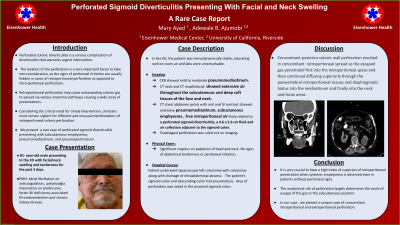Monday Poster Session
Category: Colon
P2073 - Perforated Sigmoid Diverticulitis Presenting With Facial and Neck Swelling
Monday, October 28, 2024
10:30 AM - 4:00 PM ET
Location: Exhibit Hall E

Has Audio

Mary Ayad, MD
Eisenhower Health
Rancho Mirage, CA
Presenting Author(s)
Mary Ayad, MD, Adewale Ajumobi, MD, FACG
Eisenhower Health, Rancho Mirage, CA
Introduction: Perforated colonic diverticulitis is a serious complication of diverticulitis that warrants urgent intervention. The location of the perforation influences clinical signs and symptoms. Clinicians must remain vigilant for different and unusual manifestations of retroperitoneal colonic perforation. We present a rare case of perforated sigmoid diverticulitis presenting with subcutaneous emphysema, pneumomediastinum, and pneumoperitoneum.
Case Description/Methods: An 81 year-old man presents to the emergency department (ED) with a 3 day history of swelling and pain in the face and neck. His medical history includes; atrial fibrillation on anticoagulation, polymyalgia rheumatica on prednisone, factor XII deficiency-associated thromboembolism and chronic kidney disease. Chest X-ray showed mild to moderate pneumomediastinum. Computed tomography (CT) of the neck and maxillofacial showed extensive air throughout the subcutaneous and deep soft tissues of the face and neck bilaterally. CT chest, abdomen, and pelvis showed extensive pneumomediastinum, subcutaneous emphysema, free intraperitoneal air likely related to a perforated sigmoid diverticulitis, an abscess adjacent to the sigmoid colon. Esophageal perforation was ruled out. No signs of abdominal tenderness or peritoneal irritation were noted. Patient underwent laparoscopic left colectomy with colostomy along with drainage of intraabdominal abscess.
Discussion: Perforations are predominantly intraperitoneal. However, retroperitoneal and combined types are not uncommon. Intraperitoneal perforations usually present with peritoneal symptoms. In retroperitoneal perforation, colonic gas may spread via various anatomical pathways resulting in diverse symptoms.
Our patient developed extensive subcutaneous emphysema in the neck and the trunk, which was the presenting symptom. Perforation was located in the posterior wall of the sigmoid colon, so the escaped gas penetrated first into the retroperitoneal space and then continued diffusing superiorly through the paravertebral retroperitoneal tissues and diaphragmatic hiatus into the mediastinum and finally into the neck and facial areas. It is very crucial to have a high index of suspicion of retroperitoneal perforation when systemic emphysema is observed even in patients without peritoneal signs.
Disclosures:
Mary Ayad, MD, Adewale Ajumobi, MD, FACG. P2073 - Perforated Sigmoid Diverticulitis Presenting With Facial and Neck Swelling, ACG 2024 Annual Scientific Meeting Abstracts. Philadelphia, PA: American College of Gastroenterology.
Eisenhower Health, Rancho Mirage, CA
Introduction: Perforated colonic diverticulitis is a serious complication of diverticulitis that warrants urgent intervention. The location of the perforation influences clinical signs and symptoms. Clinicians must remain vigilant for different and unusual manifestations of retroperitoneal colonic perforation. We present a rare case of perforated sigmoid diverticulitis presenting with subcutaneous emphysema, pneumomediastinum, and pneumoperitoneum.
Case Description/Methods: An 81 year-old man presents to the emergency department (ED) with a 3 day history of swelling and pain in the face and neck. His medical history includes; atrial fibrillation on anticoagulation, polymyalgia rheumatica on prednisone, factor XII deficiency-associated thromboembolism and chronic kidney disease. Chest X-ray showed mild to moderate pneumomediastinum. Computed tomography (CT) of the neck and maxillofacial showed extensive air throughout the subcutaneous and deep soft tissues of the face and neck bilaterally. CT chest, abdomen, and pelvis showed extensive pneumomediastinum, subcutaneous emphysema, free intraperitoneal air likely related to a perforated sigmoid diverticulitis, an abscess adjacent to the sigmoid colon. Esophageal perforation was ruled out. No signs of abdominal tenderness or peritoneal irritation were noted. Patient underwent laparoscopic left colectomy with colostomy along with drainage of intraabdominal abscess.
Discussion: Perforations are predominantly intraperitoneal. However, retroperitoneal and combined types are not uncommon. Intraperitoneal perforations usually present with peritoneal symptoms. In retroperitoneal perforation, colonic gas may spread via various anatomical pathways resulting in diverse symptoms.
Our patient developed extensive subcutaneous emphysema in the neck and the trunk, which was the presenting symptom. Perforation was located in the posterior wall of the sigmoid colon, so the escaped gas penetrated first into the retroperitoneal space and then continued diffusing superiorly through the paravertebral retroperitoneal tissues and diaphragmatic hiatus into the mediastinum and finally into the neck and facial areas. It is very crucial to have a high index of suspicion of retroperitoneal perforation when systemic emphysema is observed even in patients without peritoneal signs.
Disclosures:
Mary Ayad indicated no relevant financial relationships.
Adewale Ajumobi indicated no relevant financial relationships.
Mary Ayad, MD, Adewale Ajumobi, MD, FACG. P2073 - Perforated Sigmoid Diverticulitis Presenting With Facial and Neck Swelling, ACG 2024 Annual Scientific Meeting Abstracts. Philadelphia, PA: American College of Gastroenterology.
